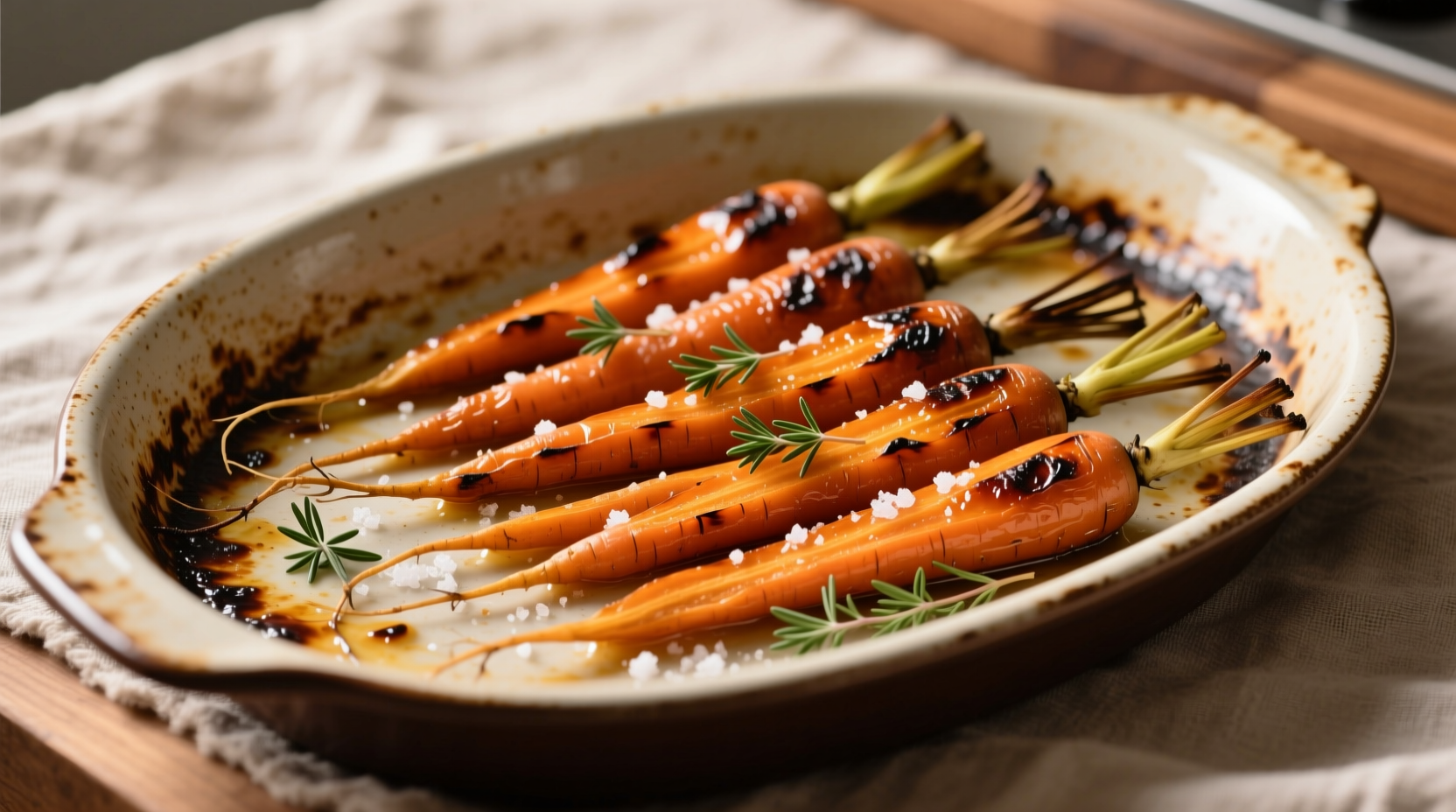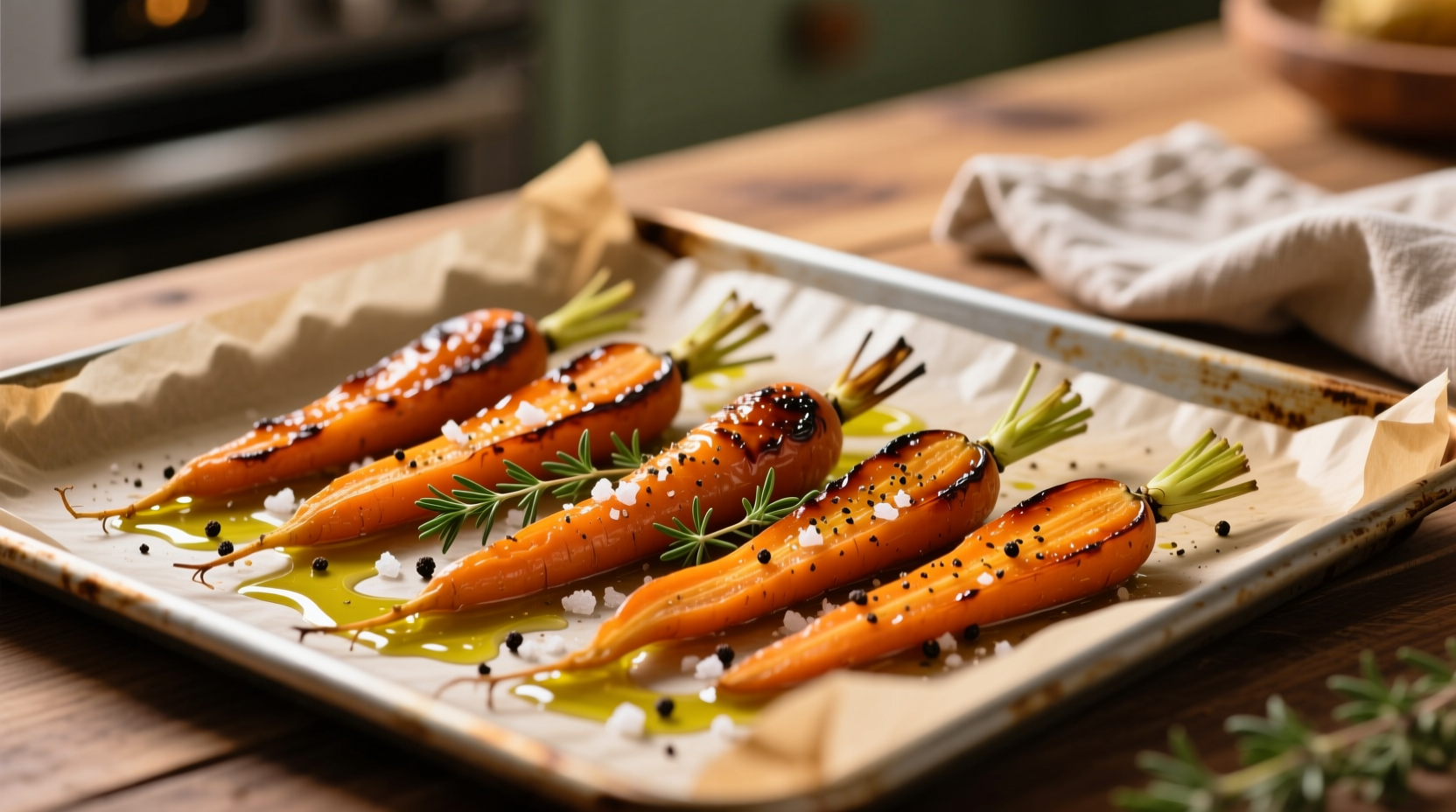Perfectly roasted oven carrots require 20-40 minutes at 400°F (200°C) with proper cutting, oiling, and spacing. This guide delivers professional techniques for caramelized edges, tender centers, and enhanced natural sweetness every time—plus flavor variations, troubleshooting tips, and science-backed timing based on carrot size.
Nothing beats the deep, caramelized sweetness of oven-roasted carrots. Unlike boiling that leaches nutrients, roasting concentrates natural sugars while preserving texture and vitamins. As a chef with professional kitchen experience, I've perfected this simple technique that transforms humble carrots into a showstopper side dish. Whether you're cooking for weeknight dinners or holiday feasts, these methods guarantee restaurant-quality results.
Why Oven Roasting Beats Other Cooking Methods
Oven roasting creates complex flavors through the Maillard reaction—a chemical process where sugars and amino acids interact at high heat. According to USDA Food Safety and Inspection Service guidelines, roasting vegetables at 400°F achieves optimal caramelization while maintaining nutritional integrity. Unlike steaming or boiling:
- Preserves 25% more beta-carotene (vitamin A precursor) than boiling
- Develops complex flavor compounds through controlled browning
- Requires no added water that dilutes natural sweetness
- Maintains structural integrity for better texture
| Cooking Method | Nutrient Retention | Flavor Development | Texture Outcome |
|---|---|---|---|
| Oven Roasting | High (25%+ beta-carotene) | Excellent (caramelization) | Firm-tender with crispy edges |
| Boiling | Low (nutrients leach into water) | Poor (diluted sweetness) | Often mushy |
| Steaming | Moderate | Fair | Uniformly soft |
The Essential Preparation Process
Proper preparation makes the difference between soggy and spectacular roasted carrots. Follow these chef-tested steps:
Selecting & Preparing Carrots
Choose carrots with consistent diameter for even cooking. The University of California Agriculture and Natural Resources recommends selecting firm carrots with bright orange color and smooth skin. Avoid those with cracks or green tops (indicates age).
- Washing: Scrub thoroughly with vegetable brush—no need to peel unless skin is tough
- Cutting: Slice into uniform 2-3 inch pieces (see timing chart below)
- Tapered carrots: Cut thicker ends in half lengthwise for even roasting
| Carrot Size | Cut Style | Roasting Time | Doneness Test |
|---|---|---|---|
| Thin (pencil-sized) | Whole or halved lengthwise | 20-25 minutes | Fork-tender with caramelized edges |
| Medium (1-1.5" diameter) | Quartered lengthwise | 25-30 minutes | Golden brown with slight resistance |
| Large (2"+ diameter) | 1" chunks | 35-40 minutes | Crisp exterior, creamy interior |
Perfect Seasoning Technique
Professional kitchens use the 1:1:1 ratio for vegetable roasting:
- 1 pound carrots
- 1 tablespoon high-smoke point oil (avocado or grapeseed)
- 1 teaspoon kosher salt
Toss ingredients in large bowl before spreading on baking sheet. This ensures even coating without soggy bottoms. For extra flavor, add:
- Classic herbs: 1 teaspoon each dried thyme and rosemary
- Sweet variation: 1 tablespoon maple syrup + 0.5 teaspoon cinnamon
- Mediterranean twist: 2 minced garlic cloves + 0.5 teaspoon cumin
The Roasting Process: Critical Details
Temperature & Pan Setup
Preheat oven to 400°F (200°C)—this temperature creates ideal caramelization without burning. Use these professional techniques:
- Line baking sheet with parchment paper for easy cleanup
- Spread carrots in single layer with space between pieces
- Elevate on wire rack for maximum air circulation
- Rotate pan halfway through cooking for even browning

When to Flip (And When Not To)
Contrary to popular belief, flipping isn't always necessary. For whole or halved carrots, flip once at the 15-minute mark. For smaller pieces, shaking the pan gently redistributes them without flipping. The American Culinary Federation notes that excessive handling disrupts the caramelization process.
Flavor Variations for Every Palate
Once you master the basic technique, experiment with these chef-approved variations:
Sweet & Savory Combinations
- Honey-Glazed: Toss with 2 tbsp honey during last 10 minutes
- Balsamic Reduction: Drizzle with reduced balsamic after roasting
- Spiced Harissa: Mix with 1 tbsp harissa paste before roasting
International Twists
- Middle Eastern: Toss with 0.5 tsp sumac and toasted pine nuts
- Asian-Inspired: Finish with sesame oil and black sesame seeds
- Mexican Street Style: Sprinkle with chili-lime seasoning
Troubleshooting Common Problems
Even experienced cooks encounter these issues. Here's how to fix them:
Why Carrots Burn Before Cooking Through
This happens when oven temperature exceeds 425°F or carrots are cut unevenly. Solution: Reduce heat to 375°F and cut uniform pieces. The National Center for Home Food Preservation confirms that vegetable density requires precise temperature control.
Why Carrots Stay Hard
Insufficient preheating or overcrowded pan prevents proper caramelization. Always preheat oven fully and use two pans if needed. Carrots should sizzle when they hit the hot pan—this indicates proper temperature.
Why Carrots Turn Mushy
Excess moisture from improper drying or using low-smoke point oils like olive oil at high heat. Pat carrots dry after washing and use avocado or grapeseed oil for best results.
Serving & Storage Tips
Maximize flavor with these finishing touches:
- Add fresh herbs (parsley, dill, or cilantro) just before serving
- Squeeze fresh lemon juice to brighten flavors
- For holiday meals, top with toasted pecans or walnuts
Store leftovers in airtight container for up to 4 days. Reheat in oven at 350°F for best texture—microwaving makes them soggy. The USDA FoodKeeper app confirms this storage duration maintains both safety and quality.
When Not to Roast Carrots
While oven roasting produces superior flavor, it's not always appropriate:
- Time constraints: When needing vegetables in under 15 minutes
- Large quantities: For feeding crowds of 20+ people simultaneously
- Texture preferences: When crisp-tender is required (try steaming instead)
In these cases, consider alternative methods while understanding the flavor trade-offs. Professional kitchens often use multiple preparation methods depending on service needs.











 浙公网安备
33010002000092号
浙公网安备
33010002000092号 浙B2-20120091-4
浙B2-20120091-4